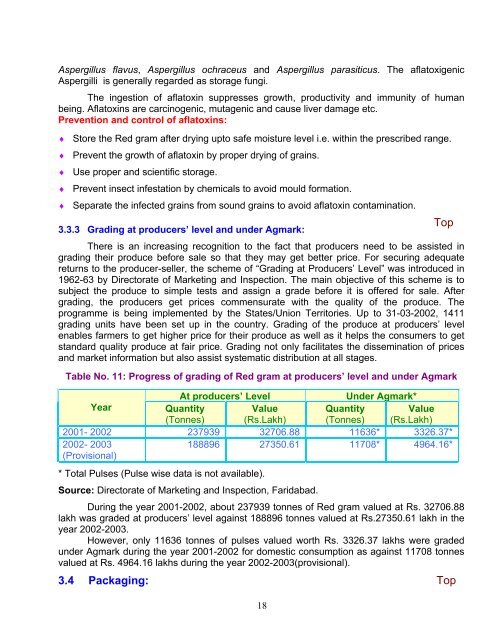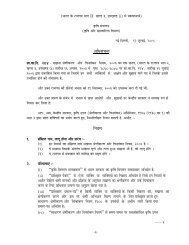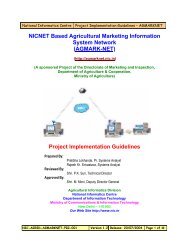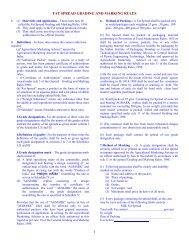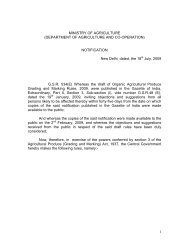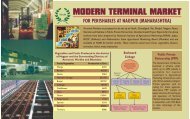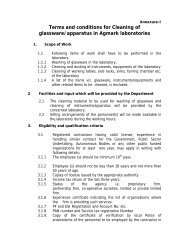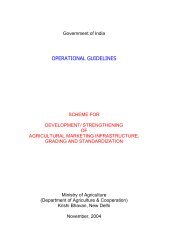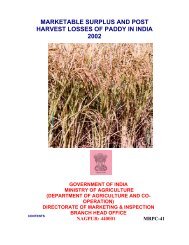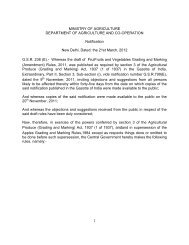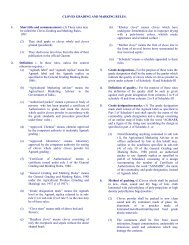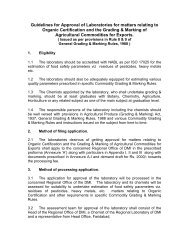Post-harvest profile of red gram - Agmarknet
Post-harvest profile of red gram - Agmarknet
Post-harvest profile of red gram - Agmarknet
You also want an ePaper? Increase the reach of your titles
YUMPU automatically turns print PDFs into web optimized ePapers that Google loves.
Aspergillus flavus, Aspergillus ochraceus and Aspergillus parasiticus. The aflatoxigenicAspergilli is generally regarded as storage fungi.The ingestion <strong>of</strong> aflatoxin suppresses growth, productivity and immunity <strong>of</strong> humanbeing. Aflatoxins are carcinogenic, mutagenic and cause liver damage etc.Prevention and control <strong>of</strong> aflatoxins:♦ Store the Red <strong>gram</strong> after drying upto safe moisture level i.e. within the prescribed range.♦ Prevent the growth <strong>of</strong> aflatoxin by proper drying <strong>of</strong> grains.♦ Use proper and scientific storage.♦♦Prevent insect infestation by chemicals to avoid mould formation.Separate the infected grains from sound grains to avoid aflatoxin contamination.3.3.3 Grading at producers’ level and under Agmark:There is an increasing recognition to the fact that producers need to be assisted ingra ding their produce before sale so that they may get better price. For securing adequatereturns to the producer-seller, the scheme <strong>of</strong> “Grading at Producers’ Level” was introduced in1962-63 by Directorate <strong>of</strong> Marketing and Inspection. The main objective <strong>of</strong> this scheme is tosubject the produce to simple tests and assign a grade before it is <strong>of</strong>fe<strong>red</strong> for sale. Aftergrading, the producers get prices commensurate with the quality <strong>of</strong> the produce. Thepro<strong>gram</strong>me is being implemented by the States/Union Territories. Up to 31-03-2002, 1411grading units have been set up in the country. Grading <strong>of</strong> the produce at producers’ levelenables farmers to get higher price for their produce as well as it helps the consumers to getstandard quality produce at fair price. Grading not only facilitates the dissemination <strong>of</strong> pricesand market information but also assist systematic distribution at all stages.Table No. 11: Progress <strong>of</strong> grading <strong>of</strong> Red <strong>gram</strong> at producers’ level and under AgmarkAt producers’ LevelUnder Agmark*YearQuantity(Tonnes)Value(Rs.Lakh)Quantity(Tonnes)Value(Rs.Lakh)2001- 2002 237939 32706.88 11636* 3326.37*2002- 2003(Provisional)188896 27350.61 11708* 4964.16** Total Pulses (Pulse wise data is not available).Source: Directorate <strong>of</strong> Marketing and Inspection, Faridabad.During the year 2001-2002, about 237939 tonnes <strong>of</strong> Red <strong>gram</strong> valued at Rs. 32706.88lakh was graded at producers’ level against 188896 tonnes valued at Rs.27350.61 lakh in theyear 2002-2003.However, only 11636 tonnes <strong>of</strong> pulses valued worth Rs. 3326.37 lakhs were gradedunder Agmark during the year 2001-2002 for domestic consumption as against 11708 tonnesvalued at Rs. 4964.16 lakhs during the year 2002-2003(provisional).3.4 Packaging:18


